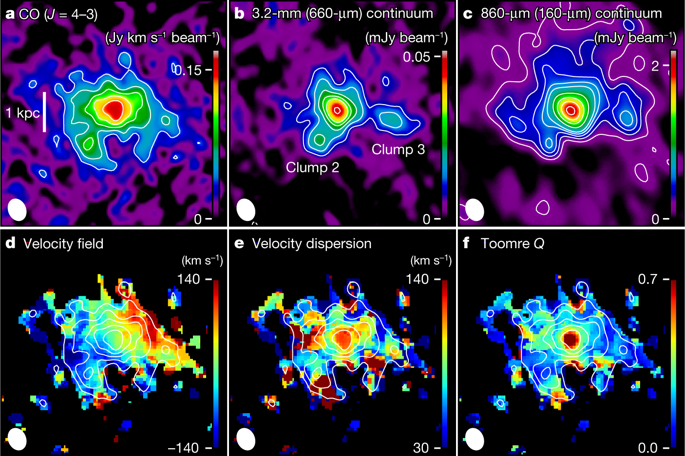Our official English website, www.x-mol.net, welcomes your feedback! (Note: you will need to create a separate account there.)
The gravitationally unstable gas disk of a starburst galaxy 12 billion years ago
Nature ( IF 64.8 ) Pub Date : 2018-08-01 , DOI: 10.1038/s41586-018-0443-1 K. Tadaki , D. Iono , M. S. Yun , I. Aretxaga , B. Hatsukade , D. H. Hughes , S. Ikarashi , T. Izumi , R. Kawabe , K. Kohno , M. Lee , Y. Matsuda , K. Nakanishi , T. Saito , Y. Tamura , J. Ueda , H. Umehata , G. W. Wilson , T. Michiyama , M. Ando , P. Kamieneski
Nature ( IF 64.8 ) Pub Date : 2018-08-01 , DOI: 10.1038/s41586-018-0443-1 K. Tadaki , D. Iono , M. S. Yun , I. Aretxaga , B. Hatsukade , D. H. Hughes , S. Ikarashi , T. Izumi , R. Kawabe , K. Kohno , M. Lee , Y. Matsuda , K. Nakanishi , T. Saito , Y. Tamura , J. Ueda , H. Umehata , G. W. Wilson , T. Michiyama , M. Ando , P. Kamieneski

|
Galaxies in the early Universe that are bright at submillimetre wavelengths (submillimetre-bright galaxies) are forming stars at a rate roughly 1,000 times higher than the Milky Way. A large fraction of the new stars form in the central kiloparsec of the galaxy1–3, a region that is comparable in size to the massive, quiescent galaxies found at the peak of cosmic star-formation history4 and the cores of present-day giant elliptical galaxies. The physical and kinematic properties inside these compact starburst cores are poorly understood because probing them at relevant spatial scales requires extremely high angular resolution. Here we report observations with a linear resolution of 550 parsecs of gas and dust in an unlensed, submillimetre-bright galaxy at a redshift of z = 4.3, when the Universe was less than two billion years old. We resolve the spatial and kinematic structure of the molecular gas inside the heavily dust-obscured core and show that the underlying gas disk is clumpy and rotationally supported (that is, its rotation velocity is larger than the velocity dispersion). Our analysis of the molecular gas mass per unit area suggests that the starburst disk is gravitationally unstable, which implies that the self-gravity of the gas is stronger than the differential rotation of the disk and the internal pressure due to stellar-radiation feedback. As a result of the gravitational instability in the disk, the molecular gas would be consumed by star formation on a timescale of 100 million years, which is comparable to gas depletion times in merging starburst galaxies5.The molecular gas in the inner kiloparsec of a submillimetre-bright galaxy is clumpy and gravitationally unstable, collapsing to form stars at a rate that will deplete the gas in about 100 million years.
中文翻译:

120亿年前星暴星系的重力不稳定气体盘
早期宇宙中在亚毫米波长下明亮的星系(亚毫米亮星系)正在以大约比银河系高 1,000 倍的速度形成恒星。大部分新恒星形成于星系 1-3 的中央千秒差距,该区域的大小与在宇宙恒星形成历史 4 和当今巨椭圆星系核心发现的大质量静止星系相当。星系。这些致密星暴核心内部的物理和运动学特性知之甚少,因为在相关空间尺度上探测它们需要极高的角分辨率。在这里,我们报告了在红移为 z = 4.3 的无透镜亚毫米亮度星系中,当宇宙年龄不到 20 亿年时,对气体和尘埃的线性分辨率为 550 秒差距的观测结果。我们解析了重度尘埃覆盖的核心内部分子气体的空间和运动学结构,并表明下面的气体盘是块状的且受到旋转支撑(即其旋转速度大于速度色散)。我们对单位面积分子气体质量的分析表明,星暴盘在重力上是不稳定的,这意味着气体的自引力强于盘的差速旋转和恒星辐射反馈引起的内部压力。由于盘中的引力不稳定性,分子气体将在 1 亿年的时间尺度上被恒星形成消耗,这与合并星暴星系中的气体消耗时间相当。
更新日期:2018-08-01
中文翻译:

120亿年前星暴星系的重力不稳定气体盘
早期宇宙中在亚毫米波长下明亮的星系(亚毫米亮星系)正在以大约比银河系高 1,000 倍的速度形成恒星。大部分新恒星形成于星系 1-3 的中央千秒差距,该区域的大小与在宇宙恒星形成历史 4 和当今巨椭圆星系核心发现的大质量静止星系相当。星系。这些致密星暴核心内部的物理和运动学特性知之甚少,因为在相关空间尺度上探测它们需要极高的角分辨率。在这里,我们报告了在红移为 z = 4.3 的无透镜亚毫米亮度星系中,当宇宙年龄不到 20 亿年时,对气体和尘埃的线性分辨率为 550 秒差距的观测结果。我们解析了重度尘埃覆盖的核心内部分子气体的空间和运动学结构,并表明下面的气体盘是块状的且受到旋转支撑(即其旋转速度大于速度色散)。我们对单位面积分子气体质量的分析表明,星暴盘在重力上是不稳定的,这意味着气体的自引力强于盘的差速旋转和恒星辐射反馈引起的内部压力。由于盘中的引力不稳定性,分子气体将在 1 亿年的时间尺度上被恒星形成消耗,这与合并星暴星系中的气体消耗时间相当。



























 京公网安备 11010802027423号
京公网安备 11010802027423号